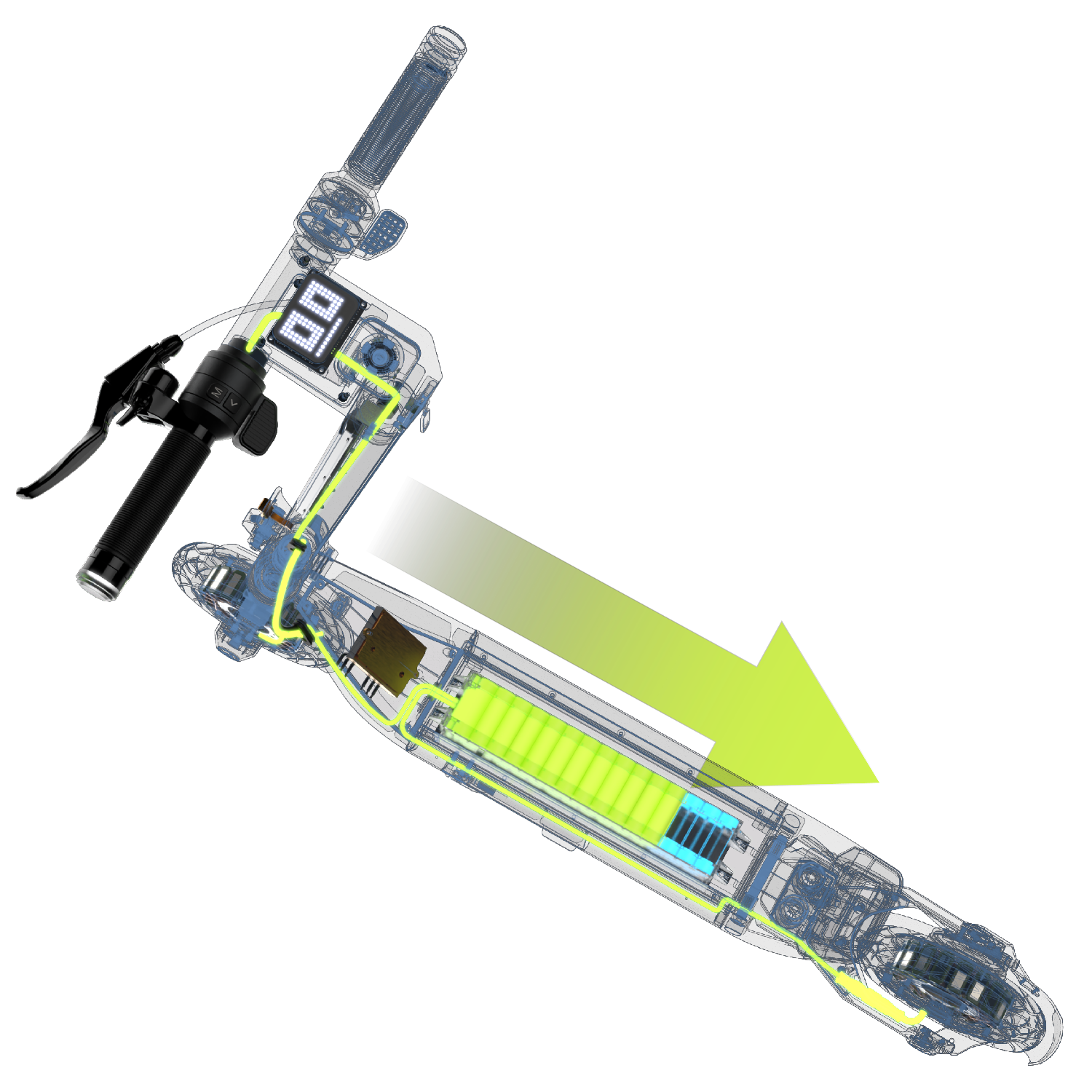Not every commute or recreational ride offers smooth pavement and perfectly groomed paths. Even well-maintained roads can be littered with twigs, stones, or other unexpected debris. Fortunately, modern electric scooters have evolved to handle rugged terrain with confidence—and safety gear has come a long way to reduce the risk of serious injuries.
In this guide, we'll explore the top design elements and rider practices that make for the best electric scooter for rough roads, and how to prepare yourself for these more demanding conditions.
Why You Need a Tough Electric Scooter for Rough Roads
Riding on rough terrain isn't just about the scooter—it's about the rider too. Uneven roads introduce bumps, loose materials like gravel and sand, and an overall higher risk of crashes. To minimize these risks “expect the unexpected” and be cautious. Here are some recommendations:
-
Stay alert to the surface and path ahead. Rough roads and trails are inconsistent that can create riding challenges. Obstacles, pot holes, gravel and sand can bog wheels down.
-
Slow down to navigate through hazards with better control.
-
Use an active riding posture to absorb bumps and sudden changes. This will allow you to reach adequately to changes in the surface or any sudden movements.
-
Accelerate and brake gradually, especially in corners or over unstable ground.
And of course, wear proper protective gear: a well-fitted helmet is a must (preferably a full face helmet), while elbow/knee pads and abrasion-resistant clothing are highly recommended for rough terrain or higher speeds. Think motorcycle grade safety gear. They can make a difference between a crash you tell your friends about and one they have to visit you in the hospital and rehab for.
Why Aren’t All Scooters Rough Road Capable?
Scooters, like their bicycle cousins, have diversified into a range of models optimized for different use cases. These allow riders to make choices that best meet their riding expectations and budgets. Some are built for ultra-light urban travel, while others are designed for speed, performance, or tackling rugged terrain.
Taking bicycles as the example:
Trek Madone SLR 9 AXS $14,850 Trek Top Fuel 9.9 XX AXS $11,550
-
Trek Madone SLR 9 AXS ($14,850): Lightweight, pavement-optimized road bike.
-
Trek Top Fuel 9.9 XX AXS ($11,550): Trail-ready mountain bike with heavy-duty suspension.
These are two premium bicycles with critical differences optimized for different riding conditions. They are both suitable for racing, but the Madone, is best for paved roads and the Top fuel, is designed for off pavement and mountain trails. The biggest difference lies in the lack of suspension in the pavement focused bicycle vs the advanced suspension in the mountain trail based bicycle. There’s also some other key differences like tire types and weight.
These bicycles are at the extreme end of purpose-built machines, there are hundreds of models and variations available to meet the needs of tens of millions of riders worldwide.
Electric scooters follow a similar path. Many entry-level or commuter models prioritize weight and affordability. But as the terrain gets more demanding, so must the electric scooter durability and design.
Key Features That Make a Scooter Durable and Road-Ready
To be considered a rugged electric scooter, a model must be more than just powerful. It must be engineered to perform under the pressures of unpredictable terrain. Look for the following features:
-
Suspension
-
Wide tires with deep thread (knobby)
-
Robust build quality.
-
Dual motors
-
Strong but also easy to modulate brakes
-
Smooth and progressive throttle response
1. Suspension and Shock Absorption
The most critical feature for a rough terrain electric scooter is its suspension system. Scooters have small wheels, which means bumps, potholes, and dips are more jarring than on a bicycle. Without suspension, these conditions can be both uncomfortable and unsafe.
-
Front and rear suspension are ideal.
-
Look for adjustable preload and rebound damping to customize the ride.
-
Alternative systems like rubber blocks or torsion suspension (e.g., Apollo Pro, Inokim OX) offer simplicity but often lack adjustability.
Here are three different suspension units. The first is non-adjustable, the second pre-load adjustable and the third pre-load and rebound adjustable.
-
Non-adjustable is self-explanatory. You have suspension, but you can’t adjust the “level”.
-
Pre-load is accomplished by screwing the ring on the shock to compress the spring. This increases the tension on the spring and the stiffness of the suspension. This is mostly important for heavier riders so the suspension does not “bottom out” or larger obstacles for the same reason.
-
Rebound is changed with the red knob in the third image. This slows the return of the shock to extend again. Systems without rebound dampening will have a tendency to bounce. Much like an automobile with worn out shock absorbers or struts.
Other systems for suspension are also employed on some scooters including compressed rubber blocks (Apollo Pro and Go, rear suspension) and torsional stressed rubber blocks (Inokim OX)) to name a few. These are less common and generally lack the ability to make adjustments that the more conventional systems allow for.
2. Wide Tires with Deep Tread
Scooter tires significantly affect riding stability, traction, and comfort:
-
Entry-level scooters typically use 8” x 2.5” tires, which are light and inexpensive but not ideal for uneven roads. They are smaller and thus offer less contact with the road surface, they sink more easily into dirt and sand and are more likely to get flat or damaged rims when encountering obstacles.
-
All-terrain electric scooters use 11” x 3.5” or larger pneumatic tires with deep tread to grip loose or muddy trails.
This helps maintain traction and reduce the chance of pinch flats or rim damage.
3. Robust Build Quality
When it comes to electric scooter durability, construction matters:
-
Look for thick aluminum or steel frames.
-
Strong folding mechanisms and stiff steering tubes.
-
Reinforced handlebars and decks.
Compare the lightweight Unagi One Classic (28.5 lbs, $995) with the heavy-duty Kaabo Wolf GT Pro (115 lbs, ~$4,000) or the Hooga Daytona (152 lbs). The difference in build reflects their intended terrain. The Unagi is highly portable and light weight but not built to handle the stresses of rough road riding. On the other hand, the Wolf GT Pro is very rough road capable.
Some attributes that are common in robust scooters will be thick metal tubing, very secure folding mechanisms, and strong stiff steering tubes and handlebars.
Hooga Daytona Scooter pictured above is very robust, weighing 152 pounds.
While these scooters are on opposite ends of lightweight vs rough road capable, there are many in between options that will deal with moderately rougher road surfaces and still be affordable and lighter in weight than these off-road monsters.
4. Dual Motor Power
Just like automobiles, traction on less than optimal surfaces is increased by using all wheel drive. Dual motor scooters apply the same amount of power to both wheels and increase stability and road handling. For rough terrain with some inclines a 2,000 watts total power (>1000W per motor) or more is ideal. Also, on rides where these powerful motors are needed they will consume a lot of energy, so a 52V battery or greater is a must.
5. High-Performance Electric Scooter Braking System
Control is crucial on rugged roads. Braking systems must be both powerful and easy to modulate. On high-performance scooters, and especially on rough roads, it’s important that the driver continues to have control of the scooter even when braking hard. Different types of brakes will perform differently in this situation:
-
Hydraulic Disk braking systems generally offer superior abilities to have progressive (many levels of braking) as well as very strong braking force when desired.
-
Regenerative braking systems (like those found on Apollo Scooters) are great for managing speed and preserving battery life. These systems can offer very controlled progressive braking using a braking throttle. This system is free from inconsistencies that can impact friction braking systems such as wet disks, uneven pad wear, brake lines in need of bleeding etc. It should be noted that the Phantom 2.0 Stellar is the best of both worlds offering high quality Hydraulic Disk brakes and exceptionally well-engineered Regenerative Braking.
6. Smooth Throttle Response
Power without control is a hazard. On well groomed pavement a scooter that has a very abrupt throttle response can be a real thrill to ride. However, on uneven terrain, even small throttle inputs can lead to jerky scooter movements, which can spiral to more accidental (or intentional) throttle inputs, more jerky movements and a bad riding experience. What’s important to keep in mind:
-
Ensure your scooter has a progressive throttle curve.
-
Test ride to confirm it doesn’t surge or lag on bumpy terrain.
-
Tip: Apollo’s controllers offer some of the best-in-class responsiveness, especially on the Phantom 2.0 Stellar.
Riding Tips: How to Handle Rough Roads Safely
To truly unlock the performance of even the best off-road electric scooter, riders need to adapt their style:
-
Use a low, balanced stance for better shock absorption.
-
Avoid sudden speed changes or hard braking.
-
On steep inclines or muddy trails, shift your weight accordingly.
Final Verdict: Choosing the Best Scooter for Your Needs
There’s no one-size-fits-all high-performance electric scooter. Choosing the best scooter for uneven roads depends on your terrain, budget, and comfort level.
-
For light trails and rough urban routes: Apollo Phantom 2.0 Stellar
-
For full off-road adventures: Look for dual-motor scooters with 11”+ pneumatic tires, advanced suspension, and hydraulic brakes.
The electric scooter market in 2025 is more diverse than ever. Whatever you choose, make sure it matches your riding goals—and most importantly, ride safe.
A Final Note on Apollo Scooters
While Apollo Scooters aren’t specifically designed for off-road or extremely rough terrain, several models—like the Phantom 2.0 Stellar—offer performance that rivals many scooters built for that purpose.
What sets the Stellar apart is its advanced controller system, delivering smooth, progressive acceleration and highly responsive regenerative braking. These features provide excellent control, even on uneven surfaces.
That said, it’s important to note that the Phantom 2.0 Stellar doesn’t come equipped with trail-optimized tires or off-road-specific suspension. Its frame is strong and durable, but it’s not intended for the constant stress of aggressive trail riding or frequent impact from rugged terrain.
If your riding includes occasional rough patches but mostly sticks to urban or mixed surfaces, the Stellar strikes a solid balance between urban agility and rough road capability—with room to upgrade tires for even better performance.
FAQ
Q: What is the best electric scooter for rough terrain?
A: The best models have dual motors, full suspension, large pneumatic tires, and strong braking systems. The Apollo Phantom 2.0 Stellar is a strong all-rounder.
Q: Are electric scooters good on bumpy roads?
A: Yes—if they have suspension, grippy tires, and good throttle and brake control.
Q: What tire size is best for rough roads?
A: At least 11” x 3.5” pneumatic tires are recommended for off-road or uneven surfaces.
Q: Is suspension more important than tire size?
A: Both are critical, but suspension plays a bigger role in shock absorption and rider comfort.
Q: Can I upgrade my current scooter for better rough road performance?
A: Yes—adding wider tires and tuning suspension settings can help, though limitations depend on the model.
Explore Apollo Scooters to see which model suits your ride.
Happy (and stable) riding!






